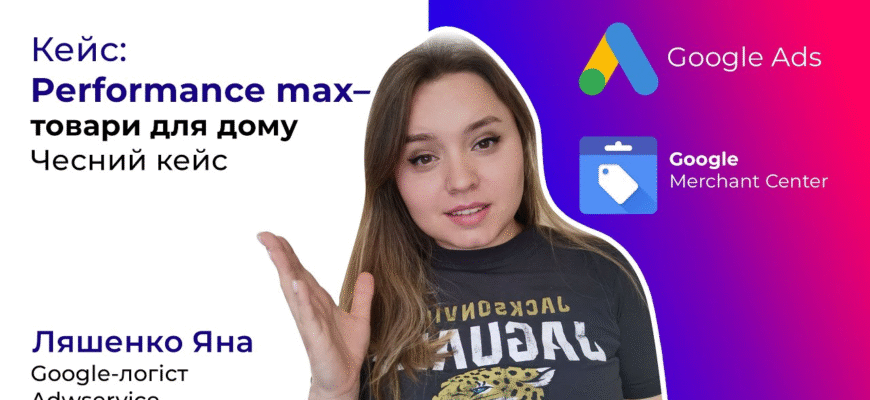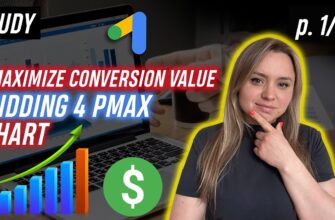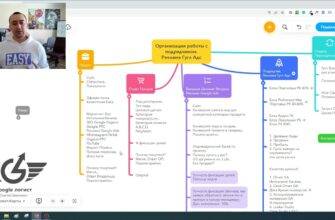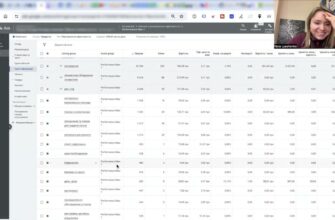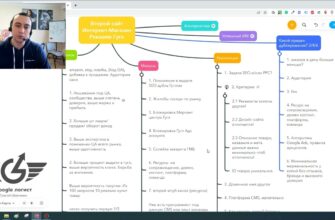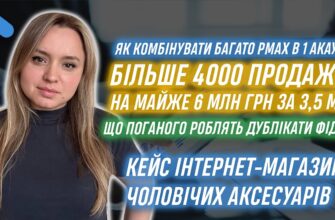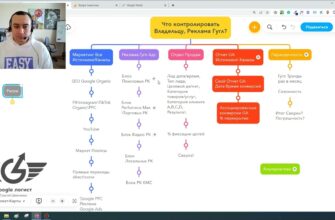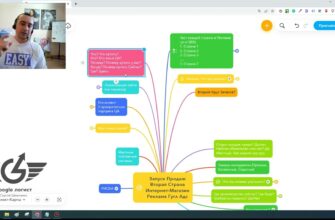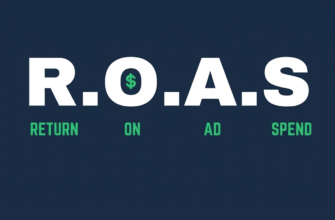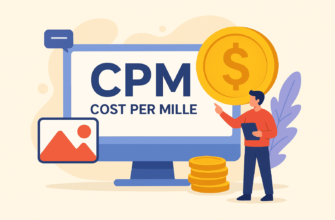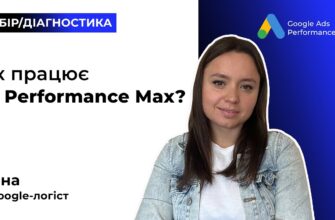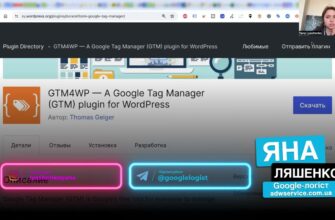- Case study and approach
- Challenges in these projects
- The problem with the variability of the product range
- Scaling issues due to the specifics of Performance Max
- The need to constantly collect analytics
- Instability of the product range
- Analysis of advertising campaign periods
- Results during the period of our support
- Client’s work with another team
- Our work with the client since October 2024
- Periods of cooperation and changing the structure of campaigns
- Problems of returning to previous results
- Our work on revising the product range
- Conclusion.
Hello, everyone. My name is Yana and I’m a Google Logistician. I am engaged in delivering the target audience to businesses with the necessary parameters and mostly scale businesses in different countries using the same AI tools directly in the Google Ads account.
Case study and approach
In today’s video, we’re going to have an honest case study. In this honest case, there will be a piece of the period before us, with us, with another team. I will now explain why the client changed us to another team to be honest. I want to have a plausible, honest case as much as possible, and not all these cases that are successful. Plus, when the client comes back to us and the difficulties that are common to these projects and that we face. If you have forgotten, let me remind you that the main thing is the difficulty of scaling any project is the typing of the business, the demand that may be present in certain niches. It is a combination of some points that we will discuss now.
This case should demonstrate to you that not everything is random in projects, that the result is a consequence of actions that are consciously applied in the account. That without a team, you can fail, reduce it all to some incomprehensible disadvantage. I will show you all this here. If you don’t understand how to scale these niches, the same thing happens. I want to show you that this project is really complicated. Even for a team, it’s quite complicated, requiring time and a lot of actions to scale.
How many calls and sales will I get by ordering contextual advertising from you?
I need to calculate the conversion of my website Describe
the task
in the application
Calculate potential ad revenue Google
contextual advertising calculator
The niche itself has specifics. Let’s talk about the specifics that are present here. Not knowing what to do if you apply, not that we are not proactive, but our team’s approach is completely different. We have a more scientific approach, we delve into product analysis. Our task is to understand why certain products work, how they work, and what signals are needed for this PMax. We have abandoned the idea that everything cannot be fully automated, only bets should be manual. We need to start with manual bets only, because AI is not reliable. It’s like still driving a cart, a horse-drawn carriage, instead of switching to an electric car or a diesel. Or just compare an automatic transmission with a manual. You can do both, but there are certain things that need to be in trend.
The situation with the AI trend and Performance is that either you try to cut it into parts and try to put it together into the puzzle that you need at point B, or you remain an old-timer, as I say. I used to be an old-fashioned person too. I believed that on manual bets, on everything that is subject to maximum adjustment on my part, I would always get a guaranteed result. No, you always have to try something new, test it, rebuild it, and adapt to new conditions.
Challenges in these projects
Let’s start with the challenges that these projects face. Let’s call this project “All household goods”. There are a lot of such projects now. They are launched and have great results. Not all of them have such a cheap price per conversion or such volumes. This is a typical problem. Moreover, it’s very important to understand that the difficulty of PAX, of scaling such projects, is that it’s difficult for PAX itself, no matter what the Googlers say, to scale everything consistently enough. You have to constantly kick it, as I say, to make it work the way it should, because it won’t understand on its own. Moreover, googlers often say: “Split the categories within one Pmax into different groups of objects.” And when you ask why they receive an uneven number of impressions, Google says that the system believes that there is no demand, no traffic, so it does not show them. And when you launch them in a certain technology, certain mechanics, it turns out that everything sells. It’s great.
The problem with the variability of the product range
The next difficulty in these projects is the variability of the product range. The variability is that some product may go out of stock and the PMax may fall. By the way, this is the most common question from specialists or businesses who come to a consultation with project data, why it broke down, and forget to delve into their product-by-product analysis. It happens that your Performance Max rakes in only one or two products. As soon as they are no longer available, everything falls apart. Therefore, you need to build the right structure so that it learns to either compensate for products from the same set that you offer it, or build a certain compensatory set of advertising campaigns.
Scaling issues due to the specifics of Performance Max
The next difficulty is that businesses, since they buy goods rather than produce them, have a desire to get the cheapest price per conversion and, accordingly, to achieve this lowest price per conversion. That’s why I added the cost/conversion graph, so that people wouldn’t see the excuse that our conversions fell because we wanted to reduce the cost per conversion.

No, to be objective, the low cost per conversion in this account has always been the result of systematic strategies, strategic actions, and a certain compensatory set of advertising campaigns. I won’t share my life hacks and tricks in this video case, because this is my own experience, because in fact, in the context of the variability of even AI tools, it is very important to be able to adapt to everything, to understand what signals to rely on, what to correct. Of course, Google is slightly extending this entire analysis period for all specialists, for businesses in the account. This is probably their own mechanics.
The need to constantly collect analytics
The next volatility of goods is something that, for example, the second team, which was inside this period, encountered, but most likely they did not understand what was happening here. Let’s face it, you can ride a very long period on pre-collected analytics because you move by inertia. But when AI doesn’t receive relevant signals, i.e. the higher the turnover, the bigger the budget, the more correct the analytics should be, because, for example, on a budget of 400 UAH, you have a 5-6% error in targeting, for example. It’s not a very big deviation from the axis, right? This is a very small gap in the budget that is being tested.
Instability of the product range
At high turnover or, for example, at large customer pieces, where the statistics are very mixed because the product range is very mixed. We don’t have 100 products in one category. We have a bunch of categories in which there can be from one item to 10-20 at most. We need to make sure that the entire account does not fall to its knees if one top category drops out. We make sure that different categories, different sets of products compensate if something happens in the account. For example, on a certain platform, where sometimes there were problems with the rejection of landing pages, something happened in Google, although the site was fine, the programmer was fine, everything was fine, everything was fine.
With such a diverse product range, you often ride on some kind of sales for a certain period of time. Then Google, not receiving the appropriate signals when targeting this product in the search results, begins to change the traffic. Very often there is a situation where your product was going up, up, up, up, conversion, everything is fine. And it may not be during the holiday season. Then it starts to be a little less for some reason. Somewhere, for example, the account was not replenished, or something else. Traffic drops a little bit more, conversions become less, then there may be no conversions for a while, and it starts to pessimize your products to zero. And these are not necessarily seasonal products, for example, Christmas garlands, like here in December, or something like that. No, it can be a product that has no seasonality at all.
We have this, for example, one of the typical ones. We have two or three product items that converted very well in different periods, and then to bring them back to the SERPs, to sell again, it’s not just a matter of running them in general campaigns or running them in separate campaigns. It’s a big chunk of time just to scale it, actually. This is another one of those nuances of product mix variability. Because without going deeper into the product range, it often happens that you sink, you don’t understand why, you introduce new adjustments and so on, but this does not lead to results for one simple reason. There is no result because you have lost the products that you have converted before due to this inertia.
And it’s not really easy to raise them. We have a whole system of mechanics that we’ve developed to lift them back into converting products, but it takes a lot of time. And it doesn’t always take a chunk of time because, as they say, agencies want clients to stay on the caliper all the time, because Google itself stretches out this process of optimizing advertising campaigns. I don’t know why it does this. When he adjusts it to Europe or the United States, where they really wait for this long period of time, not like we do – quick, quick, quick.
Analysis of advertising campaign periods
And one more nuance. I want to show this case to demonstrate that not everything happens by chance. I want to show several periods directly. The product range hasn’t really changed much. It was the same for the 23rd year, for example, when the client came to us. I even have the dates written down. And this is the period when you could get something, right?

That is, there are similarities in some periods, whether the client was with us or without us, gaps. When you’re still riding on the vapors of the analytics you’ve gained by inertia, but you make changes, you don’t know why you need to make these changes. This happens very often.
If I see a very complex and elaborate system in an audit, I try to understand it in order to understand how it affects each other. But I have seen very few such situations. If you see something in an advertising account that goes beyond the limits, how could they have done it? Think about it, maybe it was some kind of compensatory or structured approach that would give a certain amount of analytics. For AI to produce the desired result, it needs to be constantly fed with the analytics you need. Gone are the days when we would collect analytics in pieces, then cut them and come up with this price per conversion. This option is also possible, but it is quite difficult to cut the cost component now in the 25th year of the PPC market. The easiest way is to use the right analytics from the very beginning.
Results during the period of our support
Let’s get to the point of our case study. The client was with us for sure, I think he probably came in July. It was August. Here we needed an even cheaper price for conversion. You see, 37 hryvnias was great.
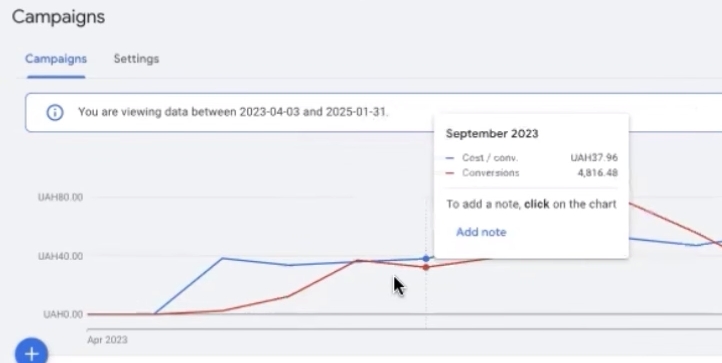
Then we revised this 37 UAH to take into account the fact that each of the price segments can have its own price per conversion. Because, for example, price segments over 900-1500 UAH, most likely, 37 UAH is really a limiting factor. This is the period. The client stayed with us until March, the end of March, this is the period of time. In fact, he was ours.

Of course, February was a down month. But we have only 4746 here. And it’s sinking more than it was, and it’s very difficult to equalize after December, right?
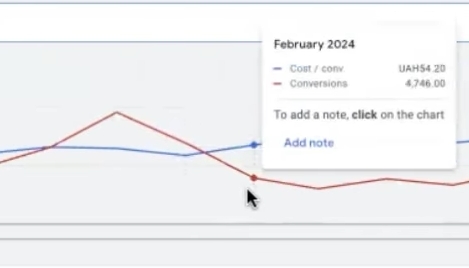
After the holidays. February began to sag in the second half of the month. This is very important, it just happened. I wrote in my Telegram channels that I saw something happening with Google, something happened there. And on March 6, instead of stabilizing to this level somewhere around, we dropped a little bit quite significantly, and by March we really couldn’t recover. Because these overlays coming from Google, we had to adapt to them. We followed a proven scheme, but here you really need to do something that can really be a conditional exception.
The client, seeing this, decides that he will test another team and try it. Of course, I also understand him. We failed to meet the target, we needed to grow and, accordingly, grow to a larger number. Of course, it’s the client’s right to try to test, it’s also normal, right? To try something new in order to understand that maybe we, as a team, are not really taking into account something. We were certainly disappointed to hear that.
Client’s work with another team
The client worked with another team for some time. I believe that it really took us three months to get there just on the analytics we collected. Sometimes people are outraged when I say that it takes three months to optimize well enough, because we’ve been collecting analytics all this time, stabilizing and gaining health, just like athletes. We have gained health, which can then be spent in subsequent periods.
How many calls and sales will I get by ordering contextual advertising from you?
I need to calculate the conversion of my website Describe
the task
in the application
Calculate potential ad revenue Google
contextual advertising calculator
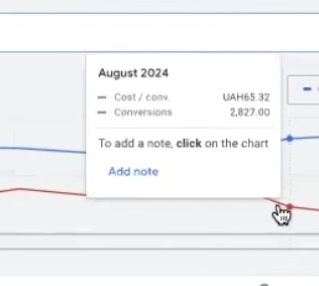
Look, it’s August of 2024. This is for those guys who tell me: “Well, you’re just showing it for the season.” Look, in August, a client with another contractor had 2,827 conversions, much less. Look, August is with us. Even with a cheaper price per conversion.
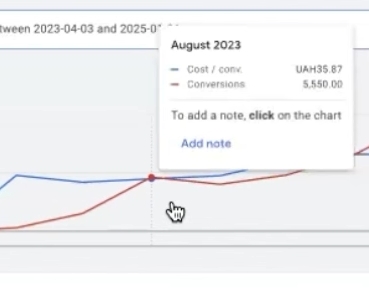
A cheaper cost per conversion is a realistic goal in some segments, which we have done. But here’s an example of not understanding why these compensatory advertising campaigns were made and starting to change the existing structure instead of scaling, which happened here, and it leads to a very rapid drop. This drop was so great, in fact, that the client has several sites and that another site, which has always been smaller, began to overtake this project. This is the story.
Our work with the client since October 2024
The client came to us, I can say, on October 14, which is October. Please, look, here’s the starting point. We have October, 14.10 is the starting point. And it turned out that for this period of time, we had very little correct analytics.
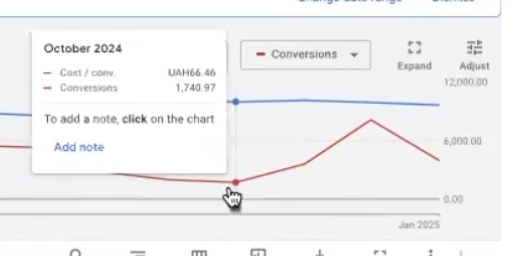
In other words, a certain advertising assortment, a certain set of products, was really converting here, and it was in the tops, and then it changed dramatically. The reason for this is that they started to change the structure very dramatically. For example, a compensatory set of advertising campaigns is a combination of certain strategies, a combination of different strategies with a certain set of product ranges that are similar or overlapping, according to certain indicators or signals when people go to our website. And when you change the mechanics completely, it’s the same as, for example, men, when they change their shoes every time they change their car, they do a camber adjustment. If you don’t do this, at best, some tires just wear out faster on some wheels than on others. And this is 10 times worse. In a few months, you’re just wearing the tires down to almost nothing on some of the wheels, ruining the rims, and you don’t see it. This is the lamest option, because you can find a lot of other causes of breakdowns there. This is something similar to that.
Periods of cooperation and changing the structure of campaigns
To get this back is the result of really hard work of the team. The client was around until December 13, he came in from October 14 to December 13, because he had to come out for the peak season. But please note that December ’24 is not equal to December ’23 in terms of the number of units.
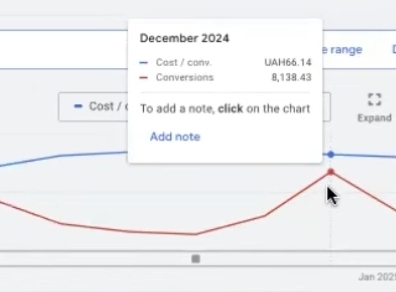
Of course, there may be problems with demand, with the market, with something else, but the problem is that we simply did not have time to return that set of goods to the shows in these two months. How can we return it? Look.
Products convert well here when they are in combos. Why combos? Because a person doesn’t make a decision when buying – I wanted this product, I googled it and bought it. No, they go through the sites, through different products within this store, add some products, fill the cart, empty it, it’s a long way for the user to go. To return just this product, which was sold before, I won’t name it, there is a set of five of them actually with this client, which can even help other products in sales, because as soon as it sank, other products similar to it went down in sales.
It’s not enough to just separate them into a separate campaign, it’s not enough to just include them in existing campaigns, because PMax doesn’t want to give him just money, that is, it doesn’t see any prospects in him. So, it turns out to be a rather complicated set of actions in order to scale it. And, indeed, the reason is that December lagged behind even in terms of the higher cost per conversion – 66 hryvnias. It is 66 UAH, by the way, not because the price per conversion has become expensive in general, but because during this period of time, the client himself has already come to the point where there are certain price ranges that can have a much more expensive price per conversion.
For example, products there cost 3000 UAH, and it will be very difficult to fit them into 40-50 UAH. But, for example, up to UAH 600, up to UAH 700, it is quite possible to fit into this price per conversion. Indeed, if you have a good enough website, so here the client was actually interested in the result. The result is lower not because we failed or the client didn’t get it from December 13, but because we didn’t gain that health in analytics to make this very similar shot.

January, of course, is a more sagging month, and indeed in January, until 13.02. And then the client comes to us from January 18. That is, most of January is simply lost in the optimization system. This is, by the way, one of the most striking examples of the fact that the bigger you get, the more you need to sustain your ad account. This is a vivid example of the fact that it’s not going to work, it’s not going to work. You can ride this very well, quite well, on some analytics that have been collected before, right? He leaves in March. 1, 2, 3, 4, 5, and then the experts start to distort it all or it happens again. You can dig into the history of changes now, if you’re interested, you can film it separately, but I don’t see the point in bringing it up in this context.
Problems of returning to previous results
This is just such a bare, clean case that shows that there are indeed situations where it is very difficult for us to get out of it. That is, there were technical nuances on the part of Google. We can’t win, we can’t reprogram, but some projects fell to their knees during these periods. Not ours, but those that came for an audit fell to a higher number of conversions. We have also stabilized here, and the price per conversion has not increased much.
We did a lot of work on stabilization, not growth. Yes, that was our fault. Until 3.04 we were, it was our fault. We took a lot of actions. And now, literally, April 24th, the same CPA.
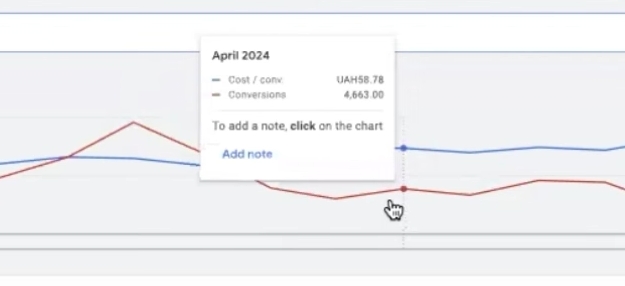
You see, we literally have a few more points, just more conversions. And here they are trying to do something. It is really not what is needed in this project. It can’t scale, so we changed the structure. And at some point, perhaps, Google sends some traffic to some products, but this is not monitored, it starts to pessimize these products, and the account is actually deleted.
I understand that for some people, 2000 sales in a month is a very good result. I understand all this perfectly well, but in fact, September 24, 2000 conversions and September 23, 4800 conversions. Yes, the price per conversion in terms of the dollar probably wouldn’t have remained the same, or rather the pound, but the number of pieces could have been the same. Immediately, we made a leap. Here he is, on October 14, the client came. Here you go. But we didn’t have time to roll it out that much. It’s something similar to the way it was rolled out here, too, it seems quite smooth. And the mountain on December 24th is just smaller for the simple reason that we didn’t have time to give a large enough pulsation.

Why does it take such a long period of time? It’s not because I want you to stay with me for six, seven months, etc. There are objective reasons for working with PMaxes. Someone comes to me with values: “I want very high profitability.” Someone comes in: “I want some specific turnover”. And we always look at the context of the situation here. Whether it can be done or not. In other words, the higher the competition in the market, the harder it is sometimes to bite off this piece.
Our work on revising the product range
By the way, during this period of time, what did we do? We also tried to shuffle part of the product range in the analytics to understand which competitor we overlap with, in which products. Because the auction statistics, I won’t go into it now, the competitors just know each other. To find this point. We no longer relied on the analytics of this period on goods, although we tried to scale it again, to return it, because that product range survived on it. That’s why we followed a well-trodden path. We conducted a series of other tests to find out if there are any products with which we have more or less overlap with our competitors, so that we could place a point bid on them and try to squeeze this piece of the auction from them.
This is also, by the way, a legal, honest way to fight for your piece of the market on the scale of the Google auction. Here we are not violating anything, we are not doing anything bad to anyone, we are fighting for a similar product range in the auction in honest formats, but this is because these niches do not have any significant categorization. It takes a chunk of time to just try to find a set of product range, because everyone is advertising the same set.
Conclusion.
Here is a vivid example of this… Guys, those who are not believers in Khoma will say that I have drawn some incomprehensible conversions. It’s all a schedule of perches and saves. Here it is, you see? It’s all perches. The numbers all match. Here you go – 8138, 11400. I don’t want you to think that I’m drawing you something incredible here. I want you to understand how it happened.

An honest, transparent case, when we were with the client, we failed on technical nuances. This is the client’s side. Whether they trust us or not is another story. We jumped on some analytics, failed to scale up, and fell. Similar periods, you can see that similar periods without reference to seasonality. Here is September without reference to November. That’s right. November wasn’t great for us either. Here, almost 7-8 thousand, here, 3600. But excuse me – to get the account off my knees, 1740 is a very small amount of analytics for this account, so that it can stretch the conversion quite well with such an assortment.
This is an example of the case I wanted to show you. Not a super-successful success, but a success, I think. She described the reasons why she didn’t even get a client for the season. I described the dates on which the client was there and on which he was not, so that you could understand the context of the picture that is happening here.

